Noodles. They are all over the world. You can find them in cheap and expensive dishes. They are such familiar, tasty friends, but what do we know about their history?
The oldest noodle
In 2005, a bowl of noodles was found. Beautifully preserved, long, thin yellow noodles were found inside an overturned sealed bowl at the Lajia archaeological site in northwestern China. The bowl was buried under ten feet (three meters) of sediment. Noodles were 4,000 years old! Houyuan Lu of the Institute of Geology and Geophysics of the Chinese Academy of Sciences in Beijing said this is “the oldest empirical evidence of noodles ever found”.

After studying the microscopic mineral particles, the researchers reported that they were made at a time when wheat was not widespread in China. Wheat was foreign to the Chinese before their travels along the Silk Road brought them the knowledge of milling. Instead of the wheat pasta that one associates with noodles, these Chinese noodles consisted of two types of millet. Millet was the original staple grain in China. It was ground into flour and processed into dough. Some rural communities in China that do not have access to wheat still use millet to make noodles in a similar way.
History
The earliest written mention of noodles comes from a book dated to the Eastern Han period (AD 25-220). Noodles, often made from wheat dough, became an important staple food during the Han Dynasty. During the Western Han Dynasty, due to the demand of the military, it was necessary for the government to introduce food processing technologies that would make it easier to store and more affordable. At this time, the “laomian” appeared. They were made from buckwheat, millet and pea flour rich in starch with a lower water content, which made them easier to store and transport.
During the Song Dynasty (960-1279), noodle shops that stayed open all night were very popular in cities. During the earlier dynastic periods, Chinese wheat noodles were known as “soup cake” (湯餅; tāng bǐng). The Song Dynasty scholar Huáng Cháo Yīng (黃朝英) mentions in his “Delightful Mixed Discourse on Various Learned Subjects” (靖康緗素雜記) that in ancient times, foods such as pasta were referred to collectively as “bing” and they differ according to the method of preparation.
Chinese noodles
Chinese noodles vary greatly by region of production , ingredients, shape or width, and method of preparation. They were invented in China and are a basic ingredient and foundation of Chinese cuisine. They are an important part of most regional cuisines in China and other countries with large overseas Chinese populations. They can be made from wheat, buckwheat, rice, millet, oats, beans, potatoes, sweet potatoes and even fish. More than 1,200 types of noodles are commonly consumed in China today. Many thousands of other dishes are prepared from these types of noodles.
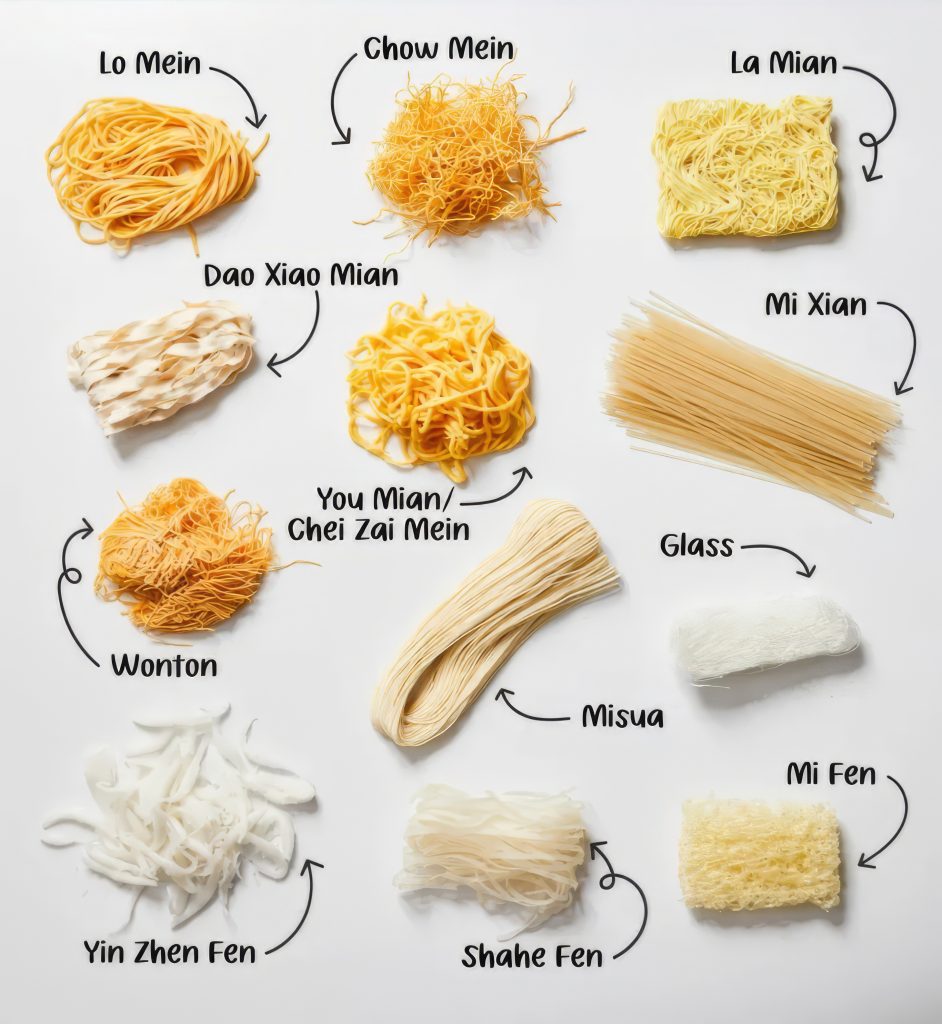
Chinese noodles have also infiltrated the cuisines of neighboring East Asian countries such as Korea and Japan, as well as Southeast Asian countries such as Vietnam, Cambodia and Thailand.
How are noodles made?
Most large-scale manufacturers today use the rolling and cutting method to produce noodles. With the roll and cut method, the dough is salted, kneaded thoroughly and left to rest. Once it reaches the desired consistency, the noodle dough is sent through a series of rollers and transformed into a long sheet. A cutting knife is attached to the last roller, which can be adjusted by the manufacturer according to the thickness. The noodle sheet is cut into two-meter strands. These two-meter tapes are moved to a drying room where they are allowed to dry naturally in the air. After a minimum of 30 hours, the noodle strips are cut and wrapped. Although this work is time-consuming, the noodles are tastier.
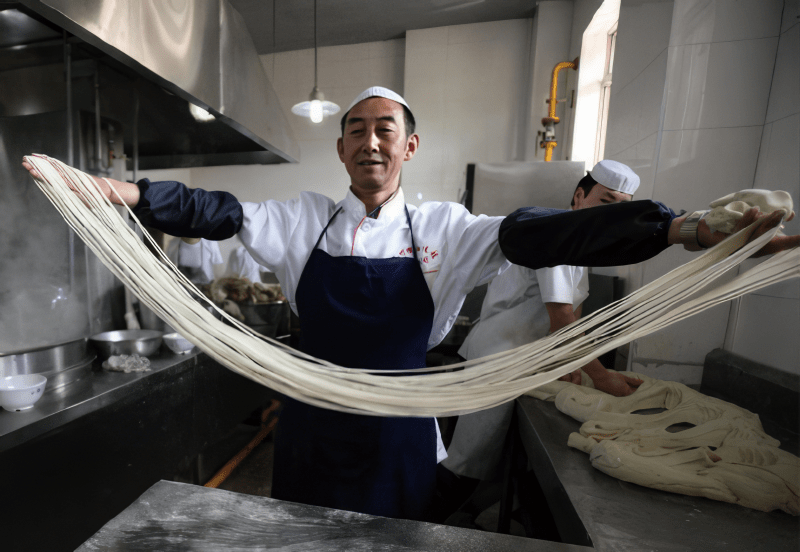
How long can I store noodles?
It will keep fresh in the fridge for three to four days. You can buy fresh frozen noodles that will last for months in the freezer.
Dried will taste best if consumed within six to seven months of purchase. You will preserve their quality by storing them in a cool and dry place.
Asian noodles vs pasta
People often confuse pasta and noodles. Pasta, a typical Italian dish, is made from durum semolina, a tetraploid type of wheat that has a coarser texture than regular wheat. Pasta makers extrude dough into various shapes by pushing it through a shaped hole. In contrast, Asian manufacturers thread, spin or cut the noodles. Traditionally, Asian noodles are made from flour ground from ordinary wheat, rice flour or starch from tubers or beans. Because traditional Asian noodles use finer flours and starches than pasta, salt is used as a binding agent in most cases, while Italian pasta usually does not use salt.
Splitting noodles
The nomenclature of Chinese noodles can be difficult due to the wide variety available in China and the many Chinese dialects used to name them. In Mandarin, miàn (simplified Chinese: 面; traditional Chinese: 麵; often translated as “mien” or “mein”) refers to noodles made from wheat flour. While fěn (粉) or “fun” refers to noodles made from other starches, especially rice flour and mung bean starch. Each type of noodle can be translated into pinyin in Mandarin. In Hong Kong and neighboring Guangdong, they will be known by the Cantonese pronunciation (“meen” or “mien” for wheat noodles, “fun” for non-wheat noodles). Wheat noodles are called mian in Mandarin, mein in Cantonese, men in Japanese, mee in Thai, and guksu in Korean.
Asian noodles
Asian noodles can generally be divided into three main types: wheat, rice and glass. However, there are countless subcategories with different preparation methods, ingredients, shapes and sizes. Check out our list of the ten most popular types of Asian noodles.
Chinese egg noodles
Chinese egg noodles are a timeless Asian noodle made from wheat flour, water and eggs. You can find them formed into thick and thin fibers. They are popular for their springy, chewy consistency. They are an essential ingredient in classic Chinese dishes such as chow mein, wonton soup and lo mein. Some sellers skimp and use food coloring to color the noodles instead of eggs, so check the ingredient labels to make sure you’re getting real egg noodles.
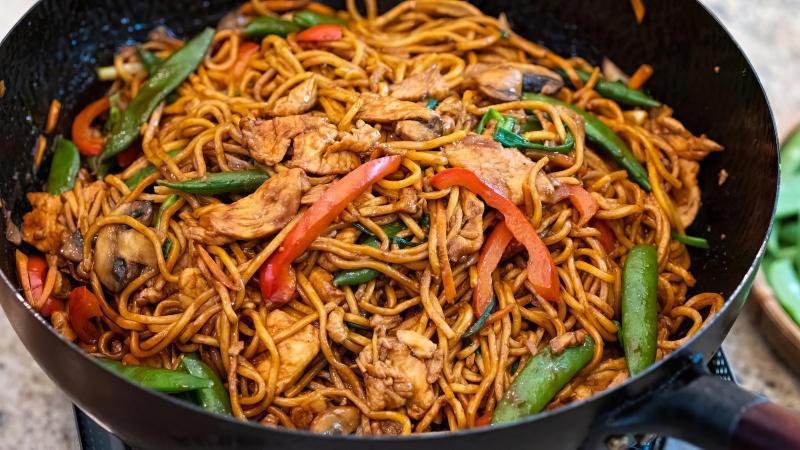
Chinese egg noodles are different from the German egg noodles known as spaetzle. Irregularly shaped and short, spaetzle are usually made from semolina flour, milk and eggs. Their consistency resembles dumplings. In contrast, classic Chinese egg noodles are long, thin and uniform. They are either round or flat and have a springy, chewy texture.
Rice noodles
You can loosely classify Asian rice noodles under the Cantonese word fun or fen. Most Asian rice noodles are made using simple recipes of rice flour and water. They come in a variety of shapes and sizes, from 5cm long and 5mm wide silver needle noodles to centimeter wide chow fun. Rice noodles are the basis of many well-known dishes such as Singapore noodles, pho and pad thai. The same basic recipe is used to make rice paper for Vietnamese summer rolls.
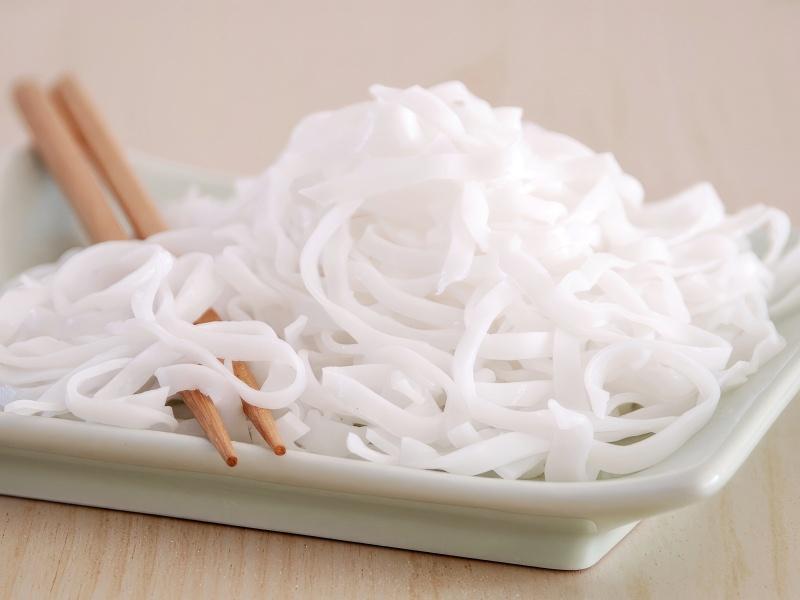
How are rice noodles cooked? It cooks much faster than wheat-based noodles, but the actual cooking time and method depends on whether the rice noodles are fresh or dry. It only takes a few minutes to cook fresh rice noodles in warm water. Cooking fresh rice noodles destroys their fragile texture. You don’t need to cook the dried rice noodles at all, just rehydrate them before adding them to the recipe.
Glass noodles
Glass noodles, also known as cellophane noodles, are thin, long noodles made from water and starch obtained from beans and tubers. Manufacturers use starch from mung beans, sweet potatoes, tapioca, peas and potatoes to make glass noodles. They are a gluten-free alternative to wheat noodles. Before purchasing glass noodles for your gluten-free diet, check the label to make sure they have not been exposed to gluten during production.

Glass noodles are not always transparent; their color varies according to the starch used. The most common type of glass noodles comes from China and is made from mung bean starch. Glass noodles made from sweet potato starch dominate the Korean and Japanese noodle markets. Tapioca noodles are very popular in Vietnam and are used to make a Central and South Vietnamese dish, crab tapioca noodle soup.
Vermicelli
The term vermicelli encompasses a broad category of thin Asian noodles. They must be less than 0.06 inches (1.5 mm) in diameter to be classified as vermicelli. The most popular type of Asian vermicelli is rice vermicelli. Rice vermicelli noodles are known as bee hoon in Hokkien Chinese, mai fun in Cantonese Chinese, wunsen in Thai, kya zan in Burmese, and bun in Vietnamese.

Since vermicelli refers to size, not composition , you will come across different types of vermicelli noodles that dominate both regional and national sales. In Vietnam, vermicelli noodles are the same as angel hair pasta. In China, you will encounter wheat vermicelli (misua) and various mung bean vermicelli noodles. Thailand is famous for its mung bean vermicelli, pad woon sen.
Ramen
Japanese ramen noodles are made famous by ramen soup, an umami-rich broth that is packed with protein, vegetables, and spices. Ramen consists of wheat flour, salt, water and kansui. Kansui is a type of mineral water and contains sodium carbonate, potassium carbonate and may contain phosphoric acid.
Kansui gives ramen noodles a distinctive yellow hue and distinguishes them from other types of Japanese noodles. It also stiffens them, preventing moisture absorption and preventing them from becoming soggy in soup recipes.

Texture plays a big role in enjoying ramen. The consistency of the ramen varies according to its shape and the length of the boil. Each degree of boiling has a specific name: bari-yawa (extra soft), yawa (soft), futsuu (medium), kata-men (hard), bari-kata (extra hard) and harigane (extra-extra hard). The firmer the noodles, the chewier the texture.
Udon
Udon is a wheat-based Japanese noodle with a thick, chewy texture and bland flavor. There are regional varieties that vary in thickness, smoothness and width. Regardless of regional design, udon has a characteristic white color. You can buy udon fresh or dried. Dried udon usually resembles fettuccine in shape and size. Fresh udon often has rounder and plumper shapes.
However, in different regions, udon is cut into unique shapes. For example, in Aomori and Iwate prefectures, udon is cut into a characteristic triangular shape before being added to the mugi kakke soup. In the Tochigi region, udon is folded into an ear shape for mimi udon soup. In the Senba region, mimi udon is a staple of New Year’s celebrations.
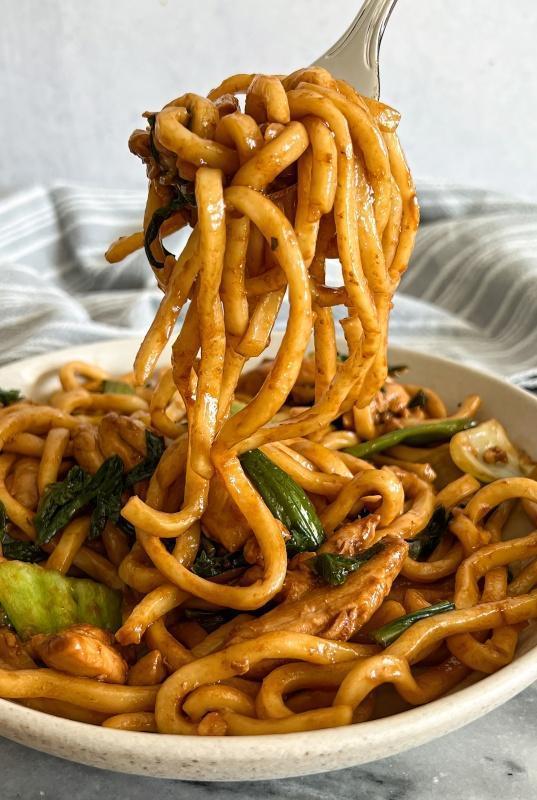
Udon are commonly served in a hot broth, which is considered a comfort food. Udon also serves as a base for Japanese curries, served cold with sauce, and added to noodle salads. Popular accompaniments to udon dishes are green onions, crushed seaweed, and Japanese chili flakes. Popular throughout Southeast Asia, udon noodles are a signature ingredient in the famous Korean dish jajangmyeon.
Reindeer
Soba are Japanese noodles made from buckwheat flour and water (soba is the Japanese word for buckwheat). Many types use a proportion of wholemeal flour to make them firmer. Pure buckwheat soba is called ju-wari soba, and 80% buckwheat soba is known as hachi-wari soba. To get real and good quality soba noodles, check the label and make sure they contain at least 70-80% buckwheat flour.

Soba contains more protein and fiber than other types of Asian noodles. People use them in hot dishes, cold salads and soups. Soba is an easy and tasty way to meet a gluten-free diet, just make sure the noodles you use are 100% buckwheat (ju-wari soba).
Some
Somen are light Japanese wheat noodles made with fine wheat flour, salt and water. After being stretched by hand into thin strips, the somen dough is coated in vegetable oil to prevent excessive drying. Due to its stringy consistency, somen can be cooked in boiling water in less than 3 minutes. As the noodles contain salt, do not add salt to the water before cooking. After cooking, rinse them in cold water to remove the oil.

Summer is hot in Japan and cold somen noodles are a popular way to cool off. Cold somen are dipped in the umami-rich tsuyu sauce, which is made by combining soy sauce, rice wine, sake, dried seaweed, and dried bonito flakes. Many restaurants create interactive serving known as nagashi somen. Restaurants opened after World War II serve nagashi somen by dropping somen noodles into a trough of running water. Customers use chopsticks to pick somen noodles out of the water and then dip them into the sauce. Somen are served in hot soups and stir-fries during the colder months.
Kalguksu are Korean noodles made from wheat flour, water and eggs, which differ from Chinese egg noodles due to the way they are prepared. Korean manufacturers roll the dough into a thin rectangle and then cut it into ribbons with a knife. Kalguksu are cut rather than strung or spun. Some types have dried bean powder or mashed mung beans added to the batter as a thickener.
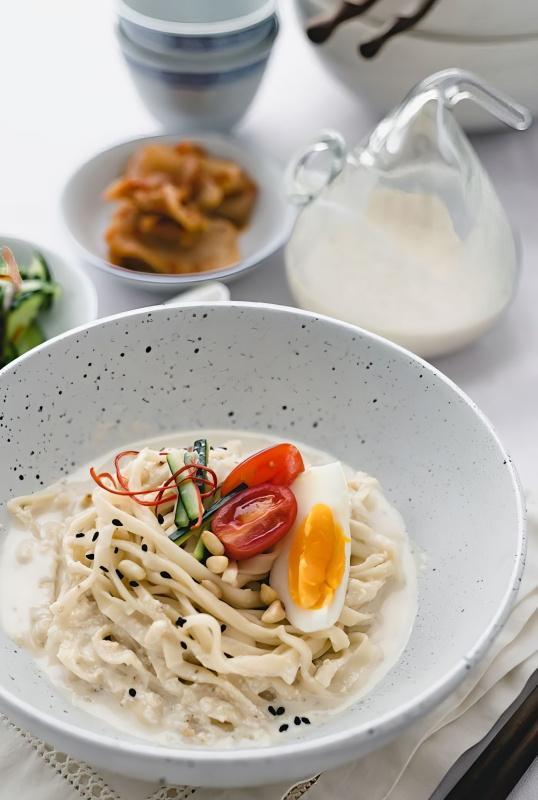
Kalguksu is considered a summer seasonal food. It is usually served in a large bowl with broth and other ingredients such as shellfish and vegetables. The traditional broth for kalguksa consists of shellfish, seaweed and dried anchovies. The second most popular choice would be chicken stock. Chefs create rich flavor by slow-cooking the broth. Kalguksu noodles are either cooked in the broth along with popular Korean vegetables such as zucchini, potatoes, and sage, or added at the end. This mild soup is often served with kimchi to give it extra flavor.
And finally
According to a Pew Research Center report , the Asian population is the fastest growing racial group in America. When this demographic reality is combined with trends in healthier eating and global cuisine, it’s no wonder that Asian-inspired dishes dominate the market. Greasy, Americanized Chinese food is no longer the only option for Asian cuisine. The modern consumer is looking for nutritious, global fusion style meals and prefers authentic Asian ingredients.






